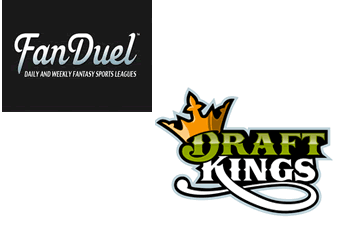 When it comes to daily fantasy NBA lineup construction, a huge chasm separates cash games from large-field NBA tournaments. If you use the same draft strategy across both categories, you’re almost guaranteed to see poor results. Cash games and tournaments are different animals. They need to be treated as such.
When it comes to daily fantasy NBA lineup construction, a huge chasm separates cash games from large-field NBA tournaments. If you use the same draft strategy across both categories, you’re almost guaranteed to see poor results. Cash games and tournaments are different animals. They need to be treated as such.
If you’re new to daily fantasy sports, you might be wondering what the term “cash games” means. We’re referring to double-ups (50/50s) and head-to-heads (H2Hs). In such contests, half the field wins – typically twice the buy-in less the fantasy site’s rake.
Cash games are often neglected by novice daily fantasy players. Most newbies are drawn to the 6-figure prize pools that are up for grabs in large-field tournaments at FanDuel and DraftKings. The irony is that double-ups and head-to-heads are easier to win. The key is knowing how to leverage the quirks posed by those two contest formats.
That’s what you’ll learn on this page. Read on for 7 actionable tips for building fantasy basketball lineups that trounce your competition in cash games.
#1 – Focus On Creating A High-Floor Lineup
The ideal roster for fantasy NBA cash games is one that has a high floor. The floor gives you a sense of security. It gives you confidence that your lineup will post a minimum number of points.
The floor isn’t etched in stone, of course. It’s based on projections, which, in turn, are based on data. The more data you have, the more confident you can be in your projections. The idea is to build an element of safety into your roster, thereby lowering your risk.
You need to draft high-floor players who have solid track records. You’re not interested in guys who post 30 points one night, and 10 points the following night. You want predictability. You need players whom you can count on to be productive.
#2 – Build Upon A Solid Foundation
In the same way a house must be built on a strong foundation, so too should your NBA daily fantasy roster. That means finding a few highly-skilled starters who play a significant number of minutes in each game. Not coincidentally, you’ll find that those same starters usually turn in solid performances night after night.
Most of the players who fit that bill are studs. Here, we’re talking about guys like LeBron James, Curry, Trae Young, Anthony Davis etc. If they’re playing, you can count on them to deliver points.
Note that studs tend to command high salaries. But assuming they play a lot of minutes, they’ll usually give you your money’s worth.
#3 – Look For Site-Specific Scoring Opportunities
 The two largest daily fantasy sites are FanDuel and DraftKings. There are slight differences in the way both sites award points in basketball contests. For example, DraftKings gives you a bonus if one of your players scores a double-double or triple-double.
The two largest daily fantasy sites are FanDuel and DraftKings. There are slight differences in the way both sites award points in basketball contests. For example, DraftKings gives you a bonus if one of your players scores a double-double or triple-double.
Think about how you might exploit that aspect of DK’s scoring system.
Suppose you need a center and you’re trying to decide between Jokic, Towns and Adebayo. You notice that Adebayo has not only logged 40+ fantasy points per game, but also ranks high in rebounds. By putting him in your lineup, you stand a good chance of earning extra points on DraftKings for a double-double.
Keep your eyes open for similar opportunities afforded by your favorite fantasy site’s scoring system. They could give you the edge you need to finish in the top half of your field.
#4 – Watch Out For Blowouts
Blowouts can be a boon if you’re competing in a guaranteed prize pool tournament. But they’re bad for business if you’re playing double-ups and head-to-heads.
Here’s the reason…
In a GPP event, you have to take risks if you want to win. Picking the same starters as everyone else only ensures you’ll post a similar score. You need to stand out from the pack. One strategy is to use Vegas odds to identify predicted blowouts, and then draft bench players from the favored teams in the hopes those players will get more floor time. More time equals more scoring opportunities.
Why might those bench players receive more time on the court? Because the starters are likely to be pulled early from the games.
It’s a risky strategy. There’s no way to tell when a starter might be pulled. Consequently, there’s no way to tell how many minutes the bench player who replaces him might get to play. But in a GPP, taking risks comes with the territory.
In a cash game, that’s a terrible approach. Remember, you want a high level of predictability. That’s why you build your roster on a strong foundation made up of a few studs. The problem is, in a blowout, those studs are likely to get pulled, reducing your roster’s scoring opportunities.
The lesson? Avoid blowouts when you’re competing in cash games. You can learn more about using Vegas odds to help you identify value here.
#5 – Pay Up For Scoring Consistency
![]() This tip is an extension of a point I’ve danced around thus far: you don’t need to take as many risks in 50/50s and H2Hs as you need to take in GPPs. You’re not looking for players who might unexpectedly turn in a show-stopping performance. On the contrary, you’re looking for guys who are consistent on the floor.
This tip is an extension of a point I’ve danced around thus far: you don’t need to take as many risks in 50/50s and H2Hs as you need to take in GPPs. You’re not looking for players who might unexpectedly turn in a show-stopping performance. On the contrary, you’re looking for guys who are consistent on the floor.
For example, consider Anthony Davis. He tends to play 35+ minutes in each game. When he’s on the court, he tends to fire off a fair number of field goals and sink more than half. He’s also consistent in rebounds and blocks.
If you add Davis to your roster, you can be relatively certain he’ll produce. His track indicates as much.
Now take a look at Mike Conley. He’s a good player, but far less consistent than Davis. His number of minutes played falls across a broader range; he fires fewer field goals and is less consistent in making them; and while he can be an effective rebounder, his production in that area is irregular, and thus unreliable.
Conley might make a good pick for a large-field tournament. If he has an awesome night, he could carry your roster to the top of the field. But he poses too much risk in a cash game, where consistency and predictability are your friends.
#6 – Check For Last-Minute Starter Injuries
Injuries happen a lot more often in professional basketball than many fantasy team owners realize. If you neglect to check for last-minute injuries, you might see one of your starters warming the bench come game time. That’s a disaster if you’re competing in a 50/50 or head-to-head.
For example, suppose you drafted Zion Williamson for tonight’s game against the Utah Jazz. He currently has a jammed left thumb and bruised right hand. The NBA injury list mentions that Williams plans to keep both of his hands on ice so he can TRY to play tonight.
That’s a huge gamble. If it turns out that he’s unable to take the floor, your roster will suffer.
Make sure you’re aware of the latest player injuries going into the evening’s tip-off. It only takes a moment to check the most recently-updated injury list.
#7 – Realize That Not Every Value Play Is A Bargain
If you’re going to put a few studs on your roster (ref. to tip #2), you’ll need to pick up a few value plays as well. That’s the only way to build your lineup under the salary cap. The challenge is being able to distinguish between players who offer real value and players who only appear to do so.
What constitutes “real value” in daily fantasy basketball? The 2 biggest factors are salary and scoring consistency.
In order for a player to qualify as a value play, he must have a lower salary than is warranted by his track record. An example would be a player scheduled to replace a starter who was recently injured. If the fantasy site hasn’t yet adjusted the replacement’s salary to reflect the extra minutes he’ll have on the floor, he might pose a fantastic value.
We’ve already covered scoring consistency and the reason it’s important in NBA cash games. But it’s worth adding a few additional notes.
First, don’t be bamboozled by the numbers listed in the “FPPG” column at FanDuel and DraftKings. They won’t tell you whether players are consistent from one game to the next.
For example, consider LaMarcus Aldridge of the Spurs. Over the last 10 games, he has scored between 10 and 37 points. That’s a huge gap. You don’t want him on your roster when he’s having an off night.
Of course, a player’s ability to sink a consistent number of field goals in each game isn’t the only thing to worry about in daily fantasy basketball. He might excel in rebounds, assists, steals and blocks. But a quick glance at Aldridge’s rebounds over the last 10 games shows a similar lack of consistency.
Not every value play is a good bargain.
A lot of novice daily fantasy team owners mistakenly assume that a low salary combined with a relatively high FPPG number reveals a great value. But those two figures rarely tell the whole story.
Last Thoughts On Daily Fantasy NBA Lineup Construction
The tips I’ve outlined above should become part of your draft strategy for NBA double-ups and head-to-heads. Incorporate them into your routine. For example, get into the habit of identifying studs, reviewing the latest injury report and checking Vegas odds for projected blowouts. Complete those tasks every time you enter a 50/50 or H2H.
With time, they’ll become second-nature to you. You’ll be able to build your NBA rosters more quickly and enjoy greater success competing against others for a chance to win real cash prizes.
Keep On Reading